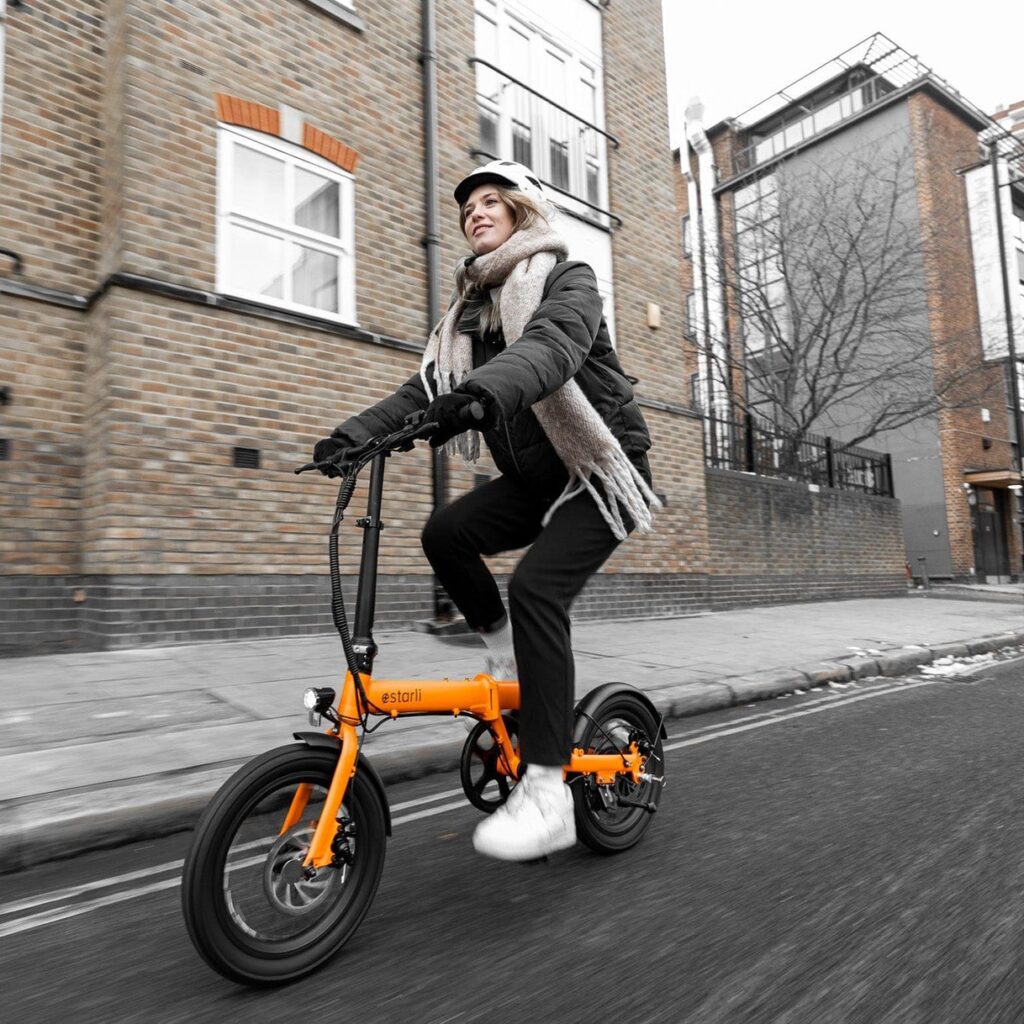Are you thinking of buying an e-bike? This should help you make up your mind.
It’s now incredibly common to see electric bikes cruising down city streets, with many urban riders now using e-bikes as their primary mode of transport.
And it’s easy to see why. They take a lot of the effort out of cycling – ideal for commuters who don’t want to arrive at work tired and sweaty – are cheaper to run than cars, and let you feel the wind in your hair while getting from A to B.
If you’ve clicked on this article, you’re probably considering buying an e-bike for yourself. Perhaps you’re already a cyclist who wants a ride that’s easier and less tiring, or maybe you currently drive but want to switch out your car journeys for a bit of exercise.
Either way, we’re here to help. Here, we’ll take a look at the benefits of e-bikes, weighing up the pros and cons of making the switch for both current cyclists and motorists.
Let’s dive in.

Understanding the Appeal of Electric Bikes
There’s plenty to love about electric bikes.
First of all, they help you to go further and faster than on a regular bike thanks to the nifty little motor which takes the strain out of cycling and gives you a boost whenever you need it, whether that’s jetting off from a red light or heaving yourself up a hill.
Statistics show that people who have an e-bike cycle more, so they’re great for getting you in the saddle more often, if that’s your goal.
Plus, they can save you money, they’re great for commuting, and they’re even safer than regular bikes in many ways.

Bicycle vs E-Bike
First of all, let’s take a look at the benefits of switching to an e-bike for current cyclists.
The Upgrade: From Traditional to Electric Bikes
It’s easy to believe that having an electric bike enhances the cycling experience. You can travel further and for longer with less effort thanks to the motor, and you’ll no longer be defeated by strong headwinds or tough climbs.
If you cycle to commute, you’ll certainly notice the difference when you can arrive at work without being drenched in sweat, exhausted and in need of a shower and a sit down before you can start your work day. Leisure riders will also feel the benefit of motor assistance, particularly if you want to tackle more difficult terrains without so much physical strain.
Statistics also show that people with e-bikes are twice as likely as regular riders to get out there and ride – largely to do with all of the benefits we’ve already mentioned – so if you already enjoy cycling but want to get out there a little more, investing in an e-bike could be the perfect choice.

Cost-Benefit Analysis for Cyclists Buying an E-Bike
Okay, there’s no two ways about it – electric bikes are expensive. You’ll generally be hard pushed to find a decent e-bike for less than £1,000, and you can spend significantly more than that for more premium models.
However, maintaining an e-bike typically costs about the same as maintenance for a regular bike. Most components are generic between regular bikes and e-bikes, and of course keeping it clean, making sure the tyres are inflated, the chain and cables are lubed and the battery is properly charged will help maintain lifespan in the long run.
You should also consider the potential long-term savings. Yes, the initial cost of an e-bike is rather high, but if you use it more to get around to your day-to-day activities, you’ll save money on fuel and public transport.
If you cycle for exercise, you could save money on a gym membership by investing in a bike you actually want to ride.
Plus, there’s no real need to worry about the cost of charging your e-bike: on average, it will cost between £0.20 to £0.40 per charge. Considering many e-bikes can get you as far as 80km on a single charge – often a whole week of commuting – this cost really is quite negligible.
Car vs Electric Bike
If you usually use a car as your primary mode of transport, making the switch to an electric bike could seem all the more daunting. However, there are so many benefits to choosing an e-bike over a car – for your wallet, for your health, and for the environment – that we’re sure you’d never look back.
The Switch: From Cars to E-Bikes
There’s no arguing with the fact that running an e-bike is more environmentally-friendly than running a car. When you consider the fact that one passenger vehicle emits 42g CO2 per kilometre, while an e-bike emits just 7g of CO2 per kilometre, the benefits are abundantly clear.
There are also personal benefits to choosing an e-bike over a car. For one, you’ll naturally get more exercise, which will boost not only physical health but mental health, too. You’ll also be able to avoid traffic by utilising urban bike lanes, enjoy greener and more scenic journeys, and explore more of your town or city than you could on four wheels.
Cost-Benefit Analysis for Car Drivers
As we mentioned earlier, it costs between £0.20 to £0.40 to fully charge an electric bike. If your e-bike can get you as far as 80km on a single charge – which might well be enough to cover all of your commutes for a week – that really isn’t much money at all.
Fuel costs are currently very expensive, and very volatile. It might cost you £50 or even £100 to fill up your car, and while this could get you 200 miles or more, that’s still far, far more expensive than the equivalent e-bike charge.
Now, we’re not going to be unrealistic and work on the basis that you’d switch ALL of your journeys to pedal power if you bought an e-bike, but you’re bound to save money on fuel by switching to cycling for even some of your commutes – and we reckon you’ll feel much better, too.
Long term savings are also significant – e-bikes are cheaper to maintain than cars, they’re cheaper or even free to park, and you don’t need to pay for MOT and road tax.
Common Concerns and Misconceptions about Electric Bikes
While e-bikes are getting increasingly popular, their relative newness means there are still a fair few concerns and misconceptions commonly held about them.
A big one is legality, and that’s fair enough, as the laws around e-bikes can be quite confusing.
In the UK, the EU and Australia, the motor on an e-bike cannot prove pedal assistance when you reach 15mph (25kph). You can, of course, ride faster than that, but it needs to be under your own steam.
In the US, the motor can legally keep going up to 20mph (32kph) on Class 2 e-bikes, or 28mph (45km/h) for Class 3.
If you’re over 14 in England, Scotland and Wales, you don’t need tax, insurance or a licence to ride an electric bike on the road – though we’d always recommend making sure you’re appropriately insured against personal accident and third-party damages.
Another common concern is battery life: no-one wants to be caught short with a flat battery. Many e-bikes can do as much as 50 miles (80km) in a single charge, but plenty can do much more than that. Plus, a lot of e-bikes have digital panels on the handlebars which tell you exactly how much battery you have remaining, and some models come with removable batteries you can switch out, or even dual batteries for twice the power.
Of course, even if the worst should happen and you run out of juice, you can still ride your e-bike like a normal bike, so you won’t be left stranded.
One of the most common claims made by cyclists about e-bikes is that they are ‘cheating’. While the motor does take the strain out of cycling in many ways, there are still plenty of health and fitness benefits to riding an e-bike – certainly more than there are to driving a car – and anything that gets people onto a bike saddle is a win in our book.
Choosing the Right E-Bike
When you’ve made the decision to buy an electric bike, next comes the fun part: bike shopping.
With so many different e-bikes on the market, it can be tricky to decide which one is right for you.
Budget will, of course, play a huge role in the decision-making process, but as with any investment, it’s generally not a good idea to skimp out on a cheaper model that might need replacing in a few years. Instead, shop around for an e-bike that’s going to offer the most long-term value, including quality components, good battery range, and durability, rather than going for the cheapest option in the short term.
It’s also important to consider your lifestyle and what you’re going to use the bike for. Will you be commuting in a city, and therefore need a nifty urban road bike? Will you be going off-road, and need a sturdier ride or even a fat bike? Do you need to be mindful of storage and consider investing in a folding e-bike? Or do you want a bike that you can ride to work on during the week, and then use to explore the countryside on weekends?
There’s an e-bike for all of these types of rider and more, so it’s worth sitting down and thinking about what you’ll use the bike for before you part with your cash.
Factors like design, style, and functionality will also play a role – no one wants to ride an ugly bike – so don’t be ashamed to take into account the look, feel, colour and design of e-bikes when you’re shopping.
Should I Buy an E-Bike?
Whether or not you should buy an electric bike ultimately comes down to your personal circumstances.
You should consider whether you can afford the initial cost, what you’re realistically going to use an e-bike for, how much it will cost in the long run compared to your current mode of transport, and how having an electric bike will impact your lifestyle.
While electric bikes are an excellent choice for lots of different kinds of rider, there’s no getting away from the fact that they are expensive pieces of kit, and you should always weigh up the pros and cons of the investment based on your own personal circumstances before taking the plunge.









